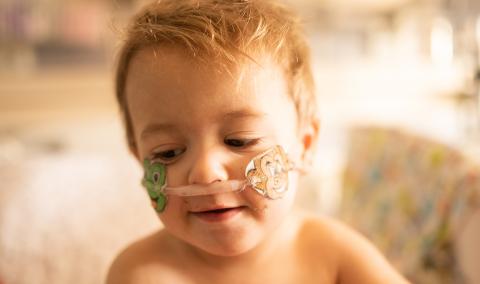Hemifacial microsomia generally refers to the under-development of one side of the face, which results in asymmetry (unevenness) of the face. This under-development happened to the baby while in utero, but researchers believe it has nothing to do with anything the mother did while pregnant.
This condition affects your child’s skull, ear, upper and lower jaws, and soft tissues, including the nerves that help move the facial muscles. Children's Health specialists at University of Missouri Children’s Hospital understand the complications of this condition and the effect it has on you and your child’s life. We are experienced in treating children with hemifacial microsomia and giving them better quality of life.
Hemifacial microsomia occurs on a spectrum, from very mild with only subtle changes, to very severe with all parts of the face and skull being affected.
Hemifacial microsomia may also be called:
- Goldenhar syndrome
- Oculo-auriculo-vertebral sequence
- First and second branchial arch syndrome
Because there is such a spectrum of deformity, it can sometimes be difficult to diagnose hemifacial microsomia. That is why an evaluation by our multidisciplinary craniofacial team is important, so that the craniofacial surgeon, geneticist and other specialists can all provide their opinions. Your child’s doctors will usually obtain special X-rays of the facial skeleton and computerized tomography (CT) scans to help with diagnosis and treatment planning.
Typically, children with hemifacial microsomia have a small or absent ear and a small upper and lower jaw on the affected side of the face. This causes a slanted or crooked smile, slanting upward toward the affected side.
Frequently asked questions about hemifacial microsomia
Check out the answers to commonly asked questions about this condition.
Is hemifacial microsomia painful?
No, hemifacial microsomia does not cause your child any discomfort.
How common is hemifacial microsomia?
It is one of the most common craniofacial anomalies, occurring in approximately one out of 5,500 newborns.
What causes hemifacial microsomia?
Hemifacial microsomia may occur sporadically – that is, as a new diagnosis with no family history – or it may be inherited (genetic).
Even in inherited cases, the severity of hemifacial microsomia is not constant. Experts believe that the blood supply to the affected side of the face may be damaged or disrupted in utero and cause of the underdevelopment on the affected side.
Are there other problems that occur with hemifacial microsomia?
Because there is a spectrum of deformity with hemifacial microsomia, other problems may arise. These can include:
- Under-development of the orbit (the eye socket)
- Under-development of the cheek bone
- Facial paralysis
- Severe thinning of the soft tissues of the cheek
What is the treatment for children with hemifacial microsomia?
While we treat every patient individually with a customized care plan, some generalizations are possible. Usually, treatment for hemifacial microsomia must address:
- Asymmetry of the jaws
- Small and/or absent ear
- Occasionally, the soft tissues of the cheek
The exact nature and timing of your child’s procedures depends upon the severity of condition in each specific case.
What sorts of specialists will be involved in my child’s care?
The optimal treatment of children with hemifacial microsomia is achieved in a multidisciplinary setting, as we have here at MU Children’s Hospital.
- Geneticists help assign a diagnosis and counsel the family regarding the possibility for recurrence in future children.
- Craniofacial surgeons are plastic surgeons who have received additional specialized training and will complete most of your child’s surgeries.
- Orthodontists help assess facial growth and development of the teeth.
- Otolaryngologists (ENT) address hearing problems or perform middle ear surgery, if necessary.
- Pediatric ophthalmologists assess vision and movement of the eyes.
- Developmental pediatricians follow your child’s physical and mental development.
- Pediatric plastic surgery nurses coordinate care, counseling and education for your family.
Related Conditions & Treatments
- Adolescent Medicine
- Chest Wall Deformities
- Down Syndrome
- Emergency Care for Kids
- Gastrostomy and Feeding Access Program
- Hyperbaric Oxygen Therapy
- Juvenile Diabetes
- Neonatology
- Pediatric Anesthesiology
- Pediatric Cancer
- Pectus Carinatum
- Pectus Excavatum
- Pediatric Cardiology
- Pediatric Dermatology
- Pediatric Development and Behavior
- Pediatric ENT (Ear, Nose and Throat)
- Pediatric Epilepsy
- Pediatric Eye Care
- Pediatric Gastroenterology
- Pediatric Infectious Diseases
- Pediatric Inpatient Rehabilitation
- Pediatric Nephrology
- Pediatric Neurology
- Pediatric Neurosurgery
- Pediatric Orthopaedics
- Pediatric Plastic Surgery
- Pediatric Primary Care
- Pediatric Psychiatry
- Pediatric Pulmonary Medicine
- Pediatric Sleep Medicine
- Pediatric Surgery
- Pediatric Surgical Services
- Pediatric Urology
- Pediatric Vascular Anomalies
- Pediatric Weight Management
- Sickle Cell Disease
- Aerodigestive Program



























